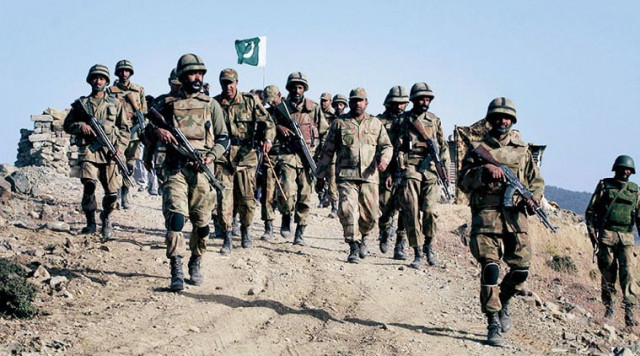Beyond soft corners and militancy
Lack of sincerity between rulers in Afghanistan, Pakistan has benefited terrorists

Tiny pockets of people have a soft corner for terrorists and believe it is a reaction to US presence across the border in Afghanistan. PHOTO: ISPR
The attack in Mohmand has drawn the ire of a large number of political parties. However, many religious-minded politicians have remained tight-lipped over the matter. Their silence is meaningful and serves to endorse allegations of a possible nexus between militants and the stalwarts of religious-minded political parties.
The terror bid in Mohmand comes weeks after scores of people lost their lives in Christian Colony in Peshawar, a district court in Mardan and Civil Hospital in Quetta.
This is not the first attack against worshippers. In the past, 11 deadly attacks of this nature have been registered in the region since 2006. No one can deny the progress made during military operations in North Waziristan and Khyber agencies. These offensives have dismantled militant networks and many of them have been forced to flee. However, this does not mean terror has been eliminated from its roots.
A majority of militants in North Waziristan and Khyber agencies slipped into safe havens in South Waziristan and Kurram agencies or into snow-capped Elum Ghar mountain, that connects Swat and Buner. Wanted commanders of all major terrorist groups have crossed the border and are living with impunity in Afghanistan.
Genesis of terror
The existing face of terror is the direct legacy of Talibanisation. The process mysteriously erupted in Afghanistan in October 1994 in the border region connecting Chaman in Balochistan and Speen Boldak in Kandahar, Afghanistan. Between 1994 and 1996, only one religious party was publically supporting Tehrik-e-Taliban Afghanistan.
Prior to the September 11, 2001 attack, at least 40 parties, groups and individuals declared their wholehearted support to the Taliban by establishing Afghanistan Defence Council during a meeting held at Darul Uloom Haqania Akora Khattak on January 11, 2001. After the general elections of October 2002, six religious parties entered into an alliance with Muttahida Majlis Amal (MMA). The party vowed to develop a system that was akin to the administrative structure established by the Taliban in Afghanistan. Traces of Talibanisation were seen during the MMA government’s rule in K-P
As 2014 drew to a close, all religious-minded leaders remain either vocal supporters of Taliban militants or were silent about the atrocities against civilians, tribal chieftains, officers, personnel of law-enforcement agencies, politicians and parliamentarians.
A shift in strategy
These groups decided to shift gears after they became signatories to the National Action Plan (NAP) after the heinous attack on Army Public School. The government and the armed forces vowed to implement NAP without discrimination. However, little has been done to give a practical shape to a counter-terrorism strategy under NAP. This has enabled terrorists to orchestrate a violent spree that has harmed civilians from time to time.
Writing on the wall
Leaders and office-bearers from different political parties have demanded the implementation of NAP since December 2014. However, the recent statement of US Special Representative for Pakistan and Afghanistan Richard Olson serves as yet another portent of doom.
During a congressional hearing, Olson admitted that progress had been made during recent military offensives in Pakistan, terrorism can only end once there is “a decisive shift in [the] policy of tolerance towards externally-focused groups”.
Pakistan and Afghanistan share similar challenges with regard to combating terrorism. If Olson’s views are anything to go by, relations between both neighbours have been impacted by border tensions and the forced repatriation of Afghan refugees. Meanwhile, in Afghanistan, there is a visible consensus on the looming crisis of terror. On the other hand, politicians, state organs and the public in Pakistan are divided over the matter.
Tiny pockets of people have a soft corner for terrorists and believe it is a reaction to US presence across the border in Afghanistan. Most of them justify it in terms of strong relations between New Delhi and Kabul.
There is a lack of sincerity between rulers of Afghanistan and Pakistan in combating the wave of militancy that has gripped the region with an iron fist. This has benefited militants and their sponsors and financiers. As a result, terror attacks occur on both sides of the border.
The time is ripe for politicians, religious leaders, ulema, intellectuals and opinion leaders to join hands against terror. If they fail to do so, Pakistan and Afghanistan will find themselves in a quandary.
Published in The Express Tribune, September 19th, 2016.












COMMENTS
Comments are moderated and generally will be posted if they are on-topic and not abusive.
For more information, please see our Comments FAQ